
The Sukhoi Su-2 was a Soviet reconnaissance and light bomber aircraft used in the early stages of World War II. It was the first airplane designed by Pavel Sukhoi. The basic design received an engine and armament upgrade (Su-4) and was modified for the ground-attack role (ShB).

The Aero A.100 was a biplane light bomber and reconnaissance aircraft built in Czechoslovakia during the 1930s. It was the final step in a design lineage that extended back to the Aero A.11 a decade earlier. A.100s remained in service throughout World War II and for a few years postwar.
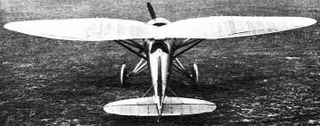
The Aero A.102 was a Czechoslovakian fighter aircraft that flew in prototype form in 1934. It was developed in response to a Czech Air Force requirement of that year, but was passed over in favour of the Avia B.35.

The Aero A.300 was a Czechoslovak bomber aircraft that first flew in 1938 as a much refined development of the A.304. It was designed by Aero to meet a requirement for a bomber-reconnaissance aircraft for the Czechoslovak Air Force, the Aero A-304 transport/bomber formed the basis for its design. It was a four-seat aircraft powered by two Bristol Mercury IX radial engines. The A-300 was faster than any other Czechoslovak aircraft in the inventory except for the Avia B-35 fighter. Despite showing much promise, development and production of the aircraft was stopped by the German occupation of Czechoslovakia.

The LWS-2 was the Polish air ambulance aircraft prototype, designed in the late-1930s in the LWS factory.
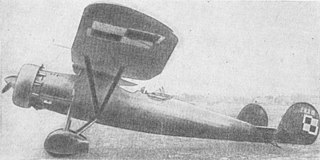
The PWS-19 was a Polish reconnaissance and bomber plane prototype of the 1930s, constructed in the PWS.
The Letov Š-16 was a Czechoslovak single-engined, two-seat biplane bomber. It was designed by Alois Šmolík at Letov Kbely. The Š-16 first flew in 1926.

The Cessna Model A is a 1920s American high-wing four-seat tourer built by the Cessna Aircraft Company, the first in a long line of high-wing single-engined monoplanes.

The Letov Š-28 was a Czechoslovak single-engined, two-seat reconnaissance aircraft. It was manufactured by Letov Kbely in a number of versions with different powerplants. The most important version was the Š-328, which was produced in relatively high quantities.
The Piaggio P.32 was an Italian medium bomber of the late 1930s, produced by Piaggio, and designed by Giovanni Pegna. It was a modern design for its time, but was a failure due to lack of powerplants commensurate with its high wing loading.
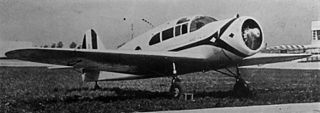
The Nardi FN.310 was an Italian four-seat touring monoplane similar but larger than the earlier Nardi FN.305 and produced by the Fratelli Nardi company.
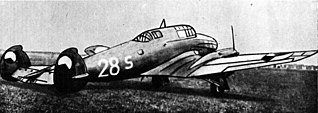
The Avia B.158 was a prototype Czechoslovak twin-engined light bomber aircraft of the 1930s. Only a single example was built and it was abandoned, following the German occupation of Czechoslovakia in March 1939.

The Avia 57 was a 1930s Czechoslovak 14-passenger commercial transport, designed by Robert Nebesář and built by Avia. The type was not a success.
The Letov Š-33 was a 1930s prototype Czechoslovakian long-range bomber, designed and built by Letov.

The Magni Vale PM-3-4 was an Italian civil monoplane for use as a tourer or aerobatic trainer designed and built by Piero Magni-Aviazione in Milan.

The Pander S-4 Postjager was a 1930s Dutch three-engined mailplane designed and built by Pander & Son. Only one was built which was destroyed during the MacRobertson Air Race.
The Farman F.420 was a twin engine monoplane, built in France in the mid-1930s to compete in a government contest for an aircraft capable of fulfilling bomber, fighter and reconnaissance roles. Two prototypes were constructed but no production followed.

The Elias EC-1 Aircoupe was an American two-seat parasol wing monoplane designed and built by Elias of Buffalo, New York.
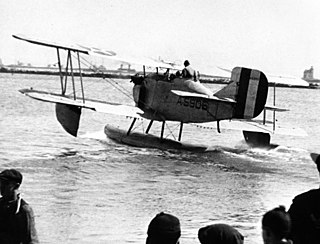
G Elias & Brother was and American manufacturer of cabinets and aircraft based in Buffalo, New York in the 1920s. A.G. Elias sat on the Manufacturers Aircraft Association's board of directors along with President Frank H. Russell, VP Glenn L. Martin, Charles L. Laurence, Chance M. Vought, S.S. Bradley, George P. Tidmarsh, and Donald Douglas. E.J Elias promoted the construction of a Buffalo municipal airport to aid the local fledgling airplane industry of five aviation companies constructing airplanes and airplane parts. From 1920 to 1925, Elias company's chief engineer, David Earle Dunlap (1896-1957), designed the Elias EM-2 Expeditionary planes. He designed the NBS-3 bomber fuselage and the Elias M-1 Mail plane. Dunlap's Elias TA-1 design was the first United States Army Air Corps Trainer to have a radial engine. After tests a McCook Field, the Army Air Corps selected other manufacturers over the Elias bomber and trainer. The company designed the Elias EM-1 to meet requirements for a multirole amphibian marine expeditionary aircraft. Elias delivered six production Elias EM-2 aircraft with Liberty engines to the United States Navy in 1922.

The Praga E-51 is a Czechoslovakian reconnaissance aircraft and light bomber built by Praga in the 1930s. Development was halted by the annexation of Czechoslovakia by Germany, after only one prototype had been built. The appearance of the construction is very reminiscent of the contemporary twin engined fighter, the Fokker G.I from Holland.

















